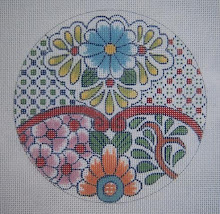 Two of the canvases are painted, and a third one begun - go see on the other blog!
Two of the canvases are painted, and a third one begun - go see on the other blog! My challenge on this one will be retaining the "look" of the watercolor, a process I thoroughly enjoy.
Patterns and Tutorials for Needlepoint and Other Fine Things
 This is just an alert to send you to the other blog (Possibilities, etc.) to see an in depth canvas preparation tutorial I've started - with children's art, as that is a simple thing for learning and practice.
This is just an alert to send you to the other blog (Possibilities, etc.) to see an in depth canvas preparation tutorial I've started - with children's art, as that is a simple thing for learning and practice.  Now the napkin ring charts! My good friend and co-conspirator Pat Miller suggested that these could also be made longer - about 7" for a cuff bracelet, and a bit longer for a bangle - and make wearable jewelry. When I have time, I'll also see if I can make little earrings to match like I did with the beaded cuff bracelets last year on the other blog.
Now the napkin ring charts! My good friend and co-conspirator Pat Miller suggested that these could also be made longer - about 7" for a cuff bracelet, and a bit longer for a bangle - and make wearable jewelry. When I have time, I'll also see if I can make little earrings to match like I did with the beaded cuff bracelets last year on the other blog.  I decided to show the marked canvases lengthwise, as the resolution could be made larger so you can see what's going on when you print them out. i.e. easier to see and to count. The first scan is of the April jewel - the diamonds.
I decided to show the marked canvases lengthwise, as the resolution could be made larger so you can see what's going on when you print them out. i.e. easier to see and to count. The first scan is of the April jewel - the diamonds. 

 While working on my crazy quilt Birthday hearts yesterday, I had one lying on it's side on my work table - and noticed the "bracelet" of diamonds looking very much like a model for a napkin ring - sooo I've been doodling on canvas again.
While working on my crazy quilt Birthday hearts yesterday, I had one lying on it's side on my work table - and noticed the "bracelet" of diamonds looking very much like a model for a napkin ring - sooo I've been doodling on canvas again. 
 The blue and green Splendor silk is what I chose to use as backgrounds - one above and one below the chain of jewels. (which are made with Sundance hexagonal clear #250 beads)
The blue and green Splendor silk is what I chose to use as backgrounds - one above and one below the chain of jewels. (which are made with Sundance hexagonal clear #250 beads) 

 I forgot to take pictures of the two instances of "dotted swiss" as I enjoy using it. First, the "JOE" mini-stocking cuff is not quite as plain and boring with the dots on it - in this case placed two stitches apart rather than one as on the chart in the post below.
I forgot to take pictures of the two instances of "dotted swiss" as I enjoy using it. First, the "JOE" mini-stocking cuff is not quite as plain and boring with the dots on it - in this case placed two stitches apart rather than one as on the chart in the post below.  The white dots on the green patch are Sundance beads.
The white dots on the green patch are Sundance beads. When I was in college, I had a year of rather intense study of textiles, in preparation for the degree in interior design. At that time - 150 years ago, the only synthetics we had were nylon, orlon, and rayon. (rayon is actually a vegetable fiber composite), so the emphasis was on fiber content and weaving techniques, with a bit of dye methods and chemicals thrown in.
When I was in college, I had a year of rather intense study of textiles, in preparation for the degree in interior design. At that time - 150 years ago, the only synthetics we had were nylon, orlon, and rayon. (rayon is actually a vegetable fiber composite), so the emphasis was on fiber content and weaving techniques, with a bit of dye methods and chemicals thrown in. 

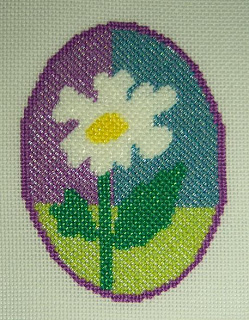 If you've ever purchased a painted canvas that you absolutely couldn't make stitch right, it was probably badly drawn before it was painted, as a well prepared canvas has to start with a good drawing - well placed on the threads where the stitches go. Too many commercial canvases these days don't take care to do this, and take the pleasure out of working them.
If you've ever purchased a painted canvas that you absolutely couldn't make stitch right, it was probably badly drawn before it was painted, as a well prepared canvas has to start with a good drawing - well placed on the threads where the stitches go. Too many commercial canvases these days don't take care to do this, and take the pleasure out of working them. 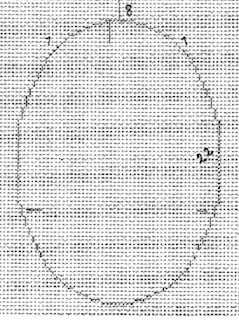 Anyway, the thing is to trace the design onto the canvas by placing it over the drawing, and do it CAREFULLY with a light touch - so as not to make an ugly, hard black line. I made the lines dark here in order to show up well.
Anyway, the thing is to trace the design onto the canvas by placing it over the drawing, and do it CAREFULLY with a light touch - so as not to make an ugly, hard black line. I made the lines dark here in order to show up well.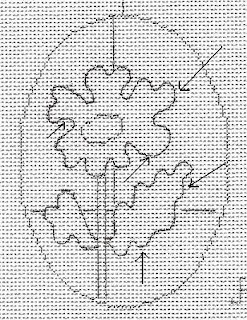 Incidentally, this drawing is the actual size of the real canvas (I think it is, anyway) so you can trace directly from it after printing it out.
Incidentally, this drawing is the actual size of the real canvas (I think it is, anyway) so you can trace directly from it after printing it out. 
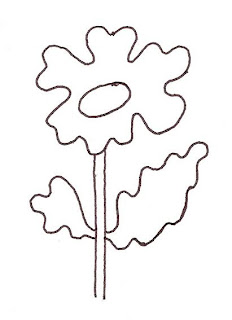
 I got a lot more stitching done on this napkin ring, but had to put it down, as deadlines are pressing for other things - there is enough done, I think, that you can see what it will look like. There is more background info on the other blog from yesterday's post.
I got a lot more stitching done on this napkin ring, but had to put it down, as deadlines are pressing for other things - there is enough done, I think, that you can see what it will look like. There is more background info on the other blog from yesterday's post. 
 A coming attraction for tomorrow - see these on my other blog. I'll put the pattern here when I get it corrected and drawn - this was just a "trial run." Gershwin music is calling tonight on TCM - a whole day of glorious music, beginning with The Great Caruso.
A coming attraction for tomorrow - see these on my other blog. I'll put the pattern here when I get it corrected and drawn - this was just a "trial run." Gershwin music is calling tonight on TCM - a whole day of glorious music, beginning with The Great Caruso.
